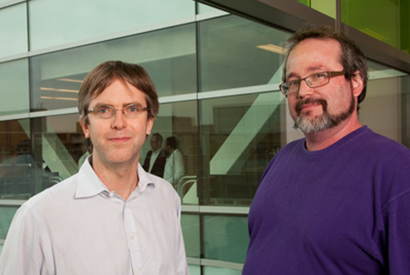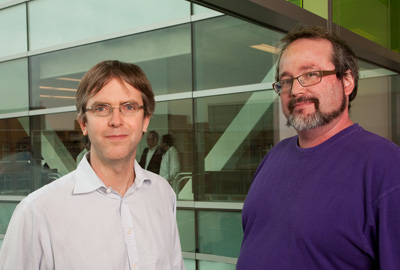NSF grant to launch world’s first open-source genetic parts production facility
Bioengineers from the UC Berkeley and Stanford University are ramping up efforts to characterize the thousands of control elements critical to the engineering of microbes so that eventually, researchers can mix and match these "DNA parts" in synthetic organisms to produce new drugs, fuels or chemicals.

January 20, 2010
With seed money from the National Science Foundation (NSF), bioengineers from the University of California, Berkeley, and Stanford University are ramping up efforts to characterize the thousands of control elements critical to the engineering of microbes so that eventually, researchers can mix and match these “DNA parts” in synthetic organisms to produce new drugs, fuels or chemicals.

Drew Endy and Adam Arkin, director and co-director, respectively, of BIOFAB, at its temporary headquarters in the Emeryville labs of the Joint BioEnergy Institute. (Margot Hartford)
Today, a single designer microbe can take years to create and cost tens of millions of dollars, since each control element – a promoter or transcription factor – has to be identified, characterized and tweaked in order to be reused. One UC Berkeley project to engineer microbes to produce the anti-malarial drug artemisinin took 10 years to get out of the lab into small-scale production, at a cost of $25 million.
The new effort, called the BIOFAB: International Open Facility Advancing Biotechnology (BIOFAB), aims to produce thousands of free, standardized DNA parts to shorten the development time and lower the cost of synthetic biology for academic or biotech laboratories. The BIOFAB has received two years of funding from the NSF and matching support from founding partners Lawrence Berkeley National Laboratory (LBNL) and the BioBricks Foundation (BBF), a non-profit organization that supports and promotes the use of synthetic biology.
“Synthetic biology has the potential to make the engineering of biology much easier and more affordable. Via the BIOFAB, we will help ensure that the public’s investments and interests in the next generation of biotechnology return the greatest benefits,” said founding BIOFAB director Drew Endy, an assistant professor in Stanford’s Bioengineering Department and president of the BioBricks Foundation.
“This is an opportunity to build a framework that will allow us to set open standards for how we do biological design in the future, so that biological parts work reliably in everyone’s hands,” said BIOFAB co-director Adam Arkin, UC Berkeley professor of bioengineering and head of Synthetic Biology for LBNL’s Physical Biosciences Division.
The BIOFAB takes its name from the fabrication, or Fab, that service laboratories established in the early semiconductor industry to make it easier for academic and small industrial labs to design and manufacture small quantities of custom chips. With computer-aided design (CAD) software, rapid-prototyping equipment and clean labs, Fab Labs could quickly produce innovative devices not yet ready for mass production.
“The professionally-staffed BIOFAB production facility will provide an essential resource that will allow many academic researchers and others to rapidly prototype, test and translate their foundational discoveries and ideas into practice,” said Jay Keasling, UC Berkeley professor of chemical engineering and of bioengineering and senior faculty scientist and acting deputy director of LBNL. “By enabling everyone to better work together, the BIOFAB will make the engineering of biology easier and more predictable.”
Keasling, who chairs the BIOFAB executive committee, led the project to biosynthesize artemisinin. He is now director in Emeryville, Calif., of the Department of Energy’s Joint BioEnergy Institute (JBEI), which focuses on developing commercially viable biofuels.
Endy and Arkin proposed a similar Fab Lab for biology more than 10 years ago, but only now, Endy said, is the time ripe for an open and cooperative full-scale production facility.
“Besides Tom Knight (of the Massachusetts Institute of Technology), very few people were talking about standard biological parts 10 years ago,” said Endy, while today, such parts are widely used by college students as part of the International Genetically Engineered Machine competition (iGEM), catalogued by institutions such as MIT and JBEI, and used daily in synthetic biology labs around the world.
Nevertheless, of the estimated 3,500 critical control elements in an E. coli bacterium, fewer than 100 have been seriously studied and characterized. Of the 500-plus promoters listed in current registries, for example, fewer than 50 have been measured, Endy said.
“What exists today is not a professional parts catalog,” Arkin said. “But the parts we have, while not perfect, are better than nothing, and they are helping researchers all over the world.”
“We now need to move beyond Lego™ metaphors and genetic toys to professional technologies,” Endy added.
Operating in partnership with the UC Berkeley-led, NSF-supported Synthetic Biology Engineering Research Center (SynBERC) directed by Keasling, the BIOFAB is raising additional funds to hire 29 full-time staff who will systematically refine, standardize and characterize the activity of each genetic control element in E. coli, so that large-scale collections of genetic parts can be treated more like standardized components. What the researchers learn will be applied to parts collections in other microbes and used to assemble engineered biological systems.
“Even though we will be building parts and making systems, we are still in the foundational research stage,” Arkin cautioned. “But in starting BIOFAB, we will accumulate the specialized know-how and the community of researchers necessary to become a resource for production and training in synthetic biology.”
The BIOFAB also will promulgate standards for technical and professional practice through application of resources such as the BioBrick Public Agreement, a new legal framework supporting open technology platforms in genetic engineering.
“The BIOFAB promises not just to deliver needed foundational technologies, but do so in support of open innovation and collaboration in biotechnology,” said David Grewal, a Harvard Fellow and BioBricks director.
To best accomplish its goals, the BIOFAB is also fully integrating ethics research within its production planning and operations.
“Our task is to generate resources and help make decisions regarding ethical issues, including safety, security and communities in genetic engineering, so that we can lead the development of open technology platforms in biotechnology that increase capacities and support human flourishing,” noted Gaymon Bennett, doctor of theology and head of BIOFAB Human Practices.
More information and announcements of open positions are available via the BIOFAB Web site.